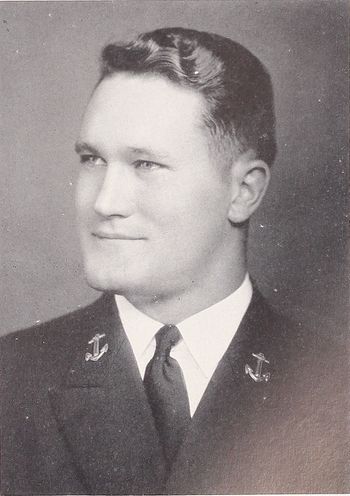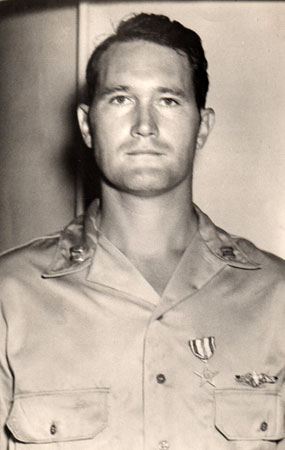THOMAS P. MCGRATH, LCDR, USN
Thomas McGrath '40
Lucky Bag
From the 1940 Lucky Bag:
THOMAS PATRICK MCGRATH
Tucson, Arizona
Tim
From the sands of Arizona "Tiny" came to the Navy ready for a scrap. Generally as gentle as a St. Bernard, nothing suits him better on the gridiron than a fight. Tom is ambitious in both athletics and academics. Plebe year it was shadow boxing his roommate, the "Shadow;" second class year, playing with a sixteen pound ball. Tiny is kind-hearted, generous, and always ready to render aid to his classmates. Claiming he is always losing weight, he diets on four desserts. A regulation fellow, well-liked, and respected by all, the Navy has in him no better material for a leader, an officer, and a gentleman.
Football N, 4, 3, 2, 1; Manager 1; Outdoor Rifle 4, 3; Boat Club 4, 3, 2, 1; 1 Stripe.
Thomas was the Regimental Commander for both 2nd and 3rd sets.

THOMAS PATRICK MCGRATH
Tucson, Arizona
Tim
From the sands of Arizona "Tiny" came to the Navy ready for a scrap. Generally as gentle as a St. Bernard, nothing suits him better on the gridiron than a fight. Tom is ambitious in both athletics and academics. Plebe year it was shadow boxing his roommate, the "Shadow;" second class year, playing with a sixteen pound ball. Tiny is kind-hearted, generous, and always ready to render aid to his classmates. Claiming he is always losing weight, he diets on four desserts. A regulation fellow, well-liked, and respected by all, the Navy has in him no better material for a leader, an officer, and a gentleman.
Football N, 4, 3, 2, 1; Manager 1; Outdoor Rifle 4, 3; Boat Club 4, 3, 2, 1; 1 Stripe.
Thomas was the Regimental Commander for both 2nd and 3rd sets.
Loss
Thomas was lost when USS Pompano (SS 181) was sunk, likely on September 17, 1943. He was the boat’s executive officer.
Other Information
From researcher Kathy Franz:
Thomas graduated from Tucson High School in 1935. He was president of the senior class and received a gold medal as “best all around boy” awarded by the faculty on the basis of leadership, scholarship, character and extra-curricular accomplishments.
From the Arizona Daily Star, Tucson, on October 18, 1942:
Biggest War That Ever Hit World, Lt. McGrath Calls It
“The people of the United States must realize that this is the biggest knock down, drag out war that has ever hit this world,” said Lieut. Thomas P. McGrath yesterday. He’s just come “off the bottom” of the Pacific where he is engineering officer on a submarine which has seen so much action in enemy waters that he has four citations for bravery in action.
Lieutenant McGrath knows just what this war is like. He has watched enemy ships, through the submarine periscope, go down in flames. He has helped prisoners on board his sub. He has heard enemy ships coming overhead and “then you hear their screws come. It sounds like a freight train coming across the top of you. Then there is the wait for the explosion – you hear the water blowing out and filling in nearby – and then you know that your elusive tactics have made the enemy miss us.”
War is Real to Him
War in the Pacific is a real and tangible quantity to this graduate of the U. S. Naval Academy at Annapolis who was commanding officer of the midshipmen’s corps during his senior year and who was awarded the “Class of 1897 Distinguished Service Sword” in recognition of his achievements. Not the honor of being named on the 1938 All-American football second team or playing guard in the hottest navy football game can compare with the feeling that comes when “you know you’ve completed your mission successfully and all the submarine’s torpedoes have been expended.”
He carries on the tradition that desert raised Arizona men make excellent naval officers. He is 24 years old, born in Bisbee and educated in the Tucson schools from the sixth grade through Tucson High, and for a short time at the University of Arizona. He is home to visit his mother, Mrs. Anna M. McGrath, 528 East Fourth street, and his sisters, Mrs. Harrison Prestley and Miss Majory McGrath. It is his first trip home in two years and he’d forgotten that October in Tucson is warmer than Honolulu.
Talks of Desert
The submarine engineering officer would much rather talk of the desert and the weather than to answer questions about his experiences on a submarine in enemy waters. Only prodding will bring from him admission of his citations and commendations for bravery and while he is entitled to wear four gold stars on his service ribbon, but one is there.
Admiral C. W. Nimitz himself signed Lieutenant McGrath’s commendation dated March 28 for “distinguished service during the Japanese attack on Pearl Harbor, Territory of Hawaii, December 7, 1941.” That commendation was for “distinguished devotion to duty and extraordinary courage and disregard of your own safety during the attack . . .” There are three endorsements to that commendation from three officers under whom the Tucsonan served.
Five Ships Sunk
“Delivered with congratulations” was Lieutenant McGrath’s commendation letter dated July 7, 1942.” From the commanding officer of Submarines, Pacific Fleet. His “performance of duty was an important and material contribution to the success of the mission” which saw his submarine “attack and sink five ships for a total destruction of --- tons of enemy shipping. All attacks were aggressive in character and were made skillfully and with determination. The patrol was conducted in enemy controlled waters and the submarine was subjected to strong antisubmarine measures by enemy forces. In spite of this, the --- return to base without damage to material or injury to personnel,” reads the citation.
“People seem to think we get on each others nerves when we’re down under for long periods,” said Lieutenant McGrath yesterday. “But you’re so darned busy that when you do get a little time off you want to sleep, play cribbage or read three-month-old magazines. Then there is the matter of trying like hell to get away from an enemy destroyer. That takes time.
Fighting Spirit
“We’re sent out to sea and we don’t come back until we accomplish our mission or expend our torpedoes. The periods of time vary. But the crews of young men are full of fighting spirit, they volunteered for the job, and they like it. Naturally, we feel very good when we’ve accomplished our mission and the captain lets every fellow look through the periscope at the ship that we’ve hit. This submarine war boils down to seeing the other fellow first and acting correctly. Hit him first and hardest, that’s our policy.
“The life down there is fine. Our food is good and we’ve our vitamin pills. We stand watch two hours on and then four hours off. We turn night into day, working on the surface at night unless the moon is too bright and staying down during the day time. We do go long periods without seeing the sun, or the moon if it is too bright. A dark and stormy night is a good night to come up, but even so enemy planes might be about.
Periscope Gets Bigger
“After a time, however, it does seem that the periscope gets progressively bigger and bigger and the ocean smaller and smaller. A bit of claustrophobia sets in. Yet, we are too busy to notice these things very much and there is the enemy always lurking around trying to get on our trail. The air is electric when you hear ‘em coming on the detectors and then that sound of freight cars and the depth charges coming. When that explosion occurs it breaks lights, knocks off paint, might even rip a tank or two open, but it is soon over.”
Lt. McGrath has been on active duty in the Pacific since his graduation in 1940 from Annapolis. That ceremony, with the awarding of the sword, seems far away, but he remembers distinctly his midshipman practice cruise in 1937 when, with his fellow midshipmen, he visited Germany, England, France and Portugal. The fervor of the German people in their enthusiasm for the Nazi cause still makes him shudder a little. That recollection coupled with Pacific operations which he has watched makes him realize “the seriousness of this war we are fighting. We need to give it all we’ve got,” he said.
His parents were listed as next of kin.
Pearl Harbor Attack
Soon after graduating Robert served aboard USS California, whose home port was Pearl Harbor. An account of the action aboard California on December 7, 1941 cites several ensigns, including Robert, among the brave men who assisted others when the ship came under attack: "Ensigns Edgar M. Fain, R.B. Canfield, Charles W. Gunnels Jr., Cary H. Hall, Stanley C. Hall, Robert D. Kirkpatrick Jr., Charles J. Lyden, Thomas P. McGrath, Archibald T. Nicholson Jr., Thomas J. Rudden Jr., Robert L. Settle '41, and William W. Walker 'displayed outstanding qualities of leadership, bravery, and coolness' while fighting fires and rescuing men."
Photographs
Silver Star
From Hall of Valor:
The President of the United States of America takes pride in presenting the Silver Star (Posthumously) to Lieutenant Thomas Patrick McGrath (NSN: 0-85072), United States Navy, for conspicuous gallantry and intrepidity in action as First Lieutenant and Damage Control Officer of the U.S.S. POMPANO (SS-181) during three successive and aggressive War Patrols of that Submarine during World War II, which resulted in the sinking of an important amount of enemy shipping. On the occasion of a surface engagement with a 900-ton armed enemy patrol vessel he manned a machine gun in an exposed station and in the face of heavy enemy machine gun fire maintained an accurate and effective fire from the gun which directly contributed to the total destruction and sinking of that enemy ship. His conduct throughout these three patrols was in keeping with the highest traditions of the United States Naval Service.
General Orders: Commander in Chief Pacific: Serial 01623 (July 11, 1943)
Action Date: World War II
Rank: Lieutenant
Company: First Lieutenant
Division: U.S.S. Pompano (SS-181)
The citation above indicates the award was posthumous, but the photo here shows him with it on his uniform.
Bronze Star
He was also awarded the Bronze Star, but unable to find the citation.
The "Register of Commissioned and Warrant Officers of the United States Navy and Marine Corps" was published annually from 1815 through at least the 1970s; it provided rank, command or station, and occasionally billet until the beginning of World War II when command/station was no longer included. Scanned copies were reviewed and data entered from the mid-1840s through 1922, when more-frequent Navy Directories were available.
The Navy Directory was a publication that provided information on the command, billet, and rank of every active and retired naval officer. Single editions have been found online from January 1915 and March 1918, and then from three to six editions per year from 1923 through 1940; the final edition is from April 1941.
The entries in both series of documents are sometimes cryptic and confusing. They are often inconsistent, even within an edition, with the name of commands; this is especially true for aviation squadrons in the 1920s and early 1930s.
Alumni listed at the same command may or may not have had significant interactions; they could have shared a stateroom or workspace, stood many hours of watch together… or, especially at the larger commands, they might not have known each other at all. The information provides the opportunity to draw connections that are otherwise invisible, though, and gives a fuller view of the professional experiences of these alumni in Memorial Hall.
June 1940
November 1940
April 1941
Memorial Hall Error
Thomas is listed as a LCDR in a majority of references. Memorial Hall gives his rank as LT.

The "category" links below lead to lists of related Honorees; use them to explore further the service and sacrifice of alumni in Memorial Hall.


